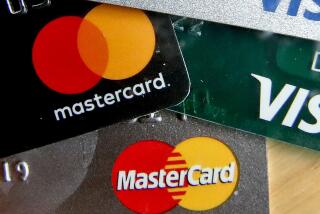From Easy Credit to Hard Knocks : Finance: Entrepreneurs who funded their start-ups with credit cards are paying the price in Bankruptcy Court.
- Share via
Marilyn August believed in the entrepreneurial dream: Anyone with enough guts and perseverance could cut the cord to corporate America and start her own business.
She found out the hard way, though, that you can’t put the American dream on your American Express. After the Huntington Beach woman quit her training job with a computer company to start a cosmetics distributorship seven years ago, excessive credit card debt forced her into bankruptcy.
August was just an early casualty in a long campaign.
Easy credit, a legacy of the debt-happy 1980s, spawned a generation of hopeful start-up businesses. Now many of them are in Bankruptcy Court, victims of credit card overextension. The cards they used as bootstraps for their businesses have become cement shoes.
Ten or 20 years ago, it was nearly impossible to finance a business on credit cards, said Ed Flynn, a management analyst for the Administrative Office of the U.S. Courts in Washington. Credit cards were not that easy to get.
Not anymore.
Now an estimated one in five entrepreneurs uses a card to get started, according to Bankcard Holders of America, a consumer education group in Herndon, Va. And a 1991 poll of 2,000 companies conducted by the Kessler Exchange in Northridge, a consulting firm for small businesses, showed that 30% were relying more often on personal credit cards because they were unable to get bank lines of credit or other loans.
“It is still very easy to get access to credit cards, with no application or approval necessary,” said Gerri Detweiler, director of Bankcard Holders. “An average consumer could acquire between $50,000 and $90,000 worth of credit if he wanted to.”
But it comes with a price.
The rate of bankruptcies has skyrocketed, and a large number of those who file are would-be entrepreneurs who tried to bankroll their nascent companies on bank credit cards only to see their efforts fail.
“About 20% of all bankruptcies are business failures, and 80% are personal,” said Paul Richard of the National Center for Financial Education, a nonprofit consumer education group in San Diego. “But of that 80%, about 40% are the result of people trying to start their own businesses, usually using personal credit cards.
“Credit card spending is such a part of the American culture that people don’t think about their real costs,” Richard said. “Some people luck out and it pays off.”
Most don’t. “It’s a killer right there to begin with,” he said. “The debt is so short-term and so very, very expensive.”
Marilyn August knows firsthand the consequences of overcharging. After she filed bankruptcy, she vowed to help others avoid the spending patterns that got her into trouble. Today she teaches courses in entrepreneurship as well as what she calls “money dynamics,” exposing the myths about money that influence people’s spending habits.
“I deal in reality checks,” she said.
Despite the help of August and other financial counselors, the problem is far from being conquered.
Bankruptcies are on the rise throughout the nation, and Southern California--historically a breeding ground for small businesses--has been especially hard hit.
The U.S. trustee’s office in Santa Ana, for example, now processes 40 to 50 creditor hearings an hour--as many as it used to in a day. “The load is almost paralyzing,” said Christian Keena, a Tustin attorney. “It’s standing room only; you would think they were giving prizes away.”
Not coincidentally, the number of credit cards in use nationally has also risen. The explosion of credit card use began in the 1980s, the result of card companies increasing their marketing efforts and easing credit restrictions to make cards available to a wider range of consumers.
In 1981, about 62 million Americans carried 116 million Mastercard or Visa cards. Ten years later, card use had peaked, with 97 million Americans holding 263 million cards.
Despite lower rates for most loans, interest rates on credit cards still average between 16% and 18%, according to the American Bankers Assn.
Outstanding credit balances also continue to grow. According to Bankcard Holders of America, nearly half of all cardholders paid their balances off each month five years ago; now fewer than a third do.
An increase in card debt does not surprise bankruptcy attorney Elizabeth Swank of Laguna Hills. In the late 1980s, the average number of cards held by her clients who filed bankruptcy was between 10 and 15, she said. Today it is between 15 and 20.
The balances on those cards have ballooned as well. “It used to be four or five years ago, the average credit card debt of someone filing bankruptcy was about $12,000,” she said. Today it is $20,000 or more. “We’re seeing a lot of biggies now.”
Bill, who asked not to be identified by his last name, was one of those biggies.
“There was a time in my life when I had between six and 10 bank accounts in four or five different states and over 40 credit cards,” said the Laguna Hills man, who now participates in Business Owners Debtors Anonymous, a 12-step recovery group similar to Alcoholics Anonymous that helps people control their urge to spend. The group is affiliated with Southern California Debtors Anonymous in Los Angeles.
Bill, a certified public accountant, used the cards to build his accounting practice, entertain clients and buy lavish gifts. “But I couldn’t tell you the difference between my personal and business finances,” he said. “I made everything a business expense.
“I used what I call CRAP--Creative Reporting and Accounting Principles,” he said. “Eventually, American Express caught up to me and said, ‘Leave home without us.’ ”
In 1985, Bill declared bankruptcy. He owed $300,000, including $125,000 in credit card debt. He owed American Express $27,000.
“My whole life was (built on) credit,” he said. “I spent one whole day a month juggling credit bills, using one card to pay another. I knew I was in over my head, but I always figured something would bail me out.”
Like another credit card. Bill said he once lied on credit applications. And because he was in a six-figure income bracket, the cards kept coming in.
Bill joined the Debtors Anonymous chapter in Laguna Hills two years ago when he caught himself sliding back into old habits. He said he is now debt-free and that his business has doubled. He lives strictly on cash. “I just took my family on a 17-day vacation and paid cash for it,” he said. “I had budgeted $2,637 for our trip, but we only spent $1,732. I came back with $900 to put back in savings.”
Despite his bankruptcy, Bill continues to get pre-approved credit card offers in the mail.
“Now,” he said, “I throw them in the trash.”
The Wayward Path
Easy credit in the 1980s helped spur countless start-up businesses. But in the 1990s, the entrepreneurial rush has given way to a torrent of personal and business bankruptcies.
Card Rich...
Typical credit card users went from carrying two cards in 1980 to holding at least three cards last year.
Mastercard, Visa and Discover cards and cardholders (in millions) 1992 Cards in circulation: 235.0 Cardholders: 87.0
U.S. bankruptcy fillings in thousands
Chapter 7
1992: 679.7
Chapter 11
1992: 24.0
Chapter 13
1992: 267.1
Total
1992: 970.8
Glossary
Chapter 7: Allows businesses and individuals to keep some personal property and in some instances, their home and automobile. But they must sell the rest to pay off at least part of what is owed.
Chapter 11: Provides businesses protection from creditors while reorganizing operations and establishing a pryment plan.
Chapter 13: Allows individuals protection from creditors and allows payments to be extended up to five years.
Sources: Bankcard Holders of America; Administrative Office of the U.S. Courts, Bankruptcy Division; Researched by CAROL SMITH / Los Angeles Times
More to Read
Inside the business of entertainment
The Wide Shot brings you news, analysis and insights on everything from streaming wars to production — and what it all means for the future.
You may occasionally receive promotional content from the Los Angeles Times.










